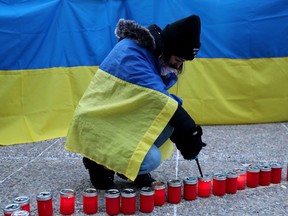Alberta can help Ukraine’s energy sector recover from the devastating effects of Russia’s invasion.
“Over the decades, Alberta’s energy workers have accumulated a vast storehouse of knowledge and expertise — from geophysics to drilling to completions to pipelines. We are thrilled to share our experience to help Ukraine rebuild — and in the process learn a few things ourselves.”
That’s the focus of a new memorandum of understanding between Alberta and Ukraine’s Ministry of Energy that, once inked, is expected to establish closer collaboration and support in the energy sector.
As part of the yet-to-be-unveiled MOU, Alberta will strive to provide advisory and physical support for the reconstruction of Ukrainian energy infrastructure, which has suffered heavy losses in the conflict, now in its second year, as of Saturday, Feb. 24.
Ukraine’s production of petroleum and other liquids declined by 70 per cent between 2021 and 2022. Crude oil and equivalent production in Ukraine declined by 80 per cent during the same period, said a recent Alberta government news release.
Urgent needs in Ukraine’s energy sector include everything from energy equipment to repairing networks and critical energy infrastructure, as well as much-needed fuel.
“Over the decades, Alberta’s energy workers have accumulated a vast storehouse of knowledge and expertise — from geophysics to drilling to completions to pipelines. We are thrilled to share our experience to help Ukraine rebuild — and in the process learn a few things ourselves,” said Energy Minister Brian Jean.
The announcement mentioned “exploring new sources of energy” as one potential area of co-operation, along with hydrocarbon development, electricity, energy efficiency, reducing emissions, and developing technology.
The partnership could include guidance on other initiatives, such as personnel training, contracting processes, capacity building and innovation, said the release.
Guided by 1994 Declaration
The MOU, set for a five-year run, is “guided by the objectives and principles of the Joint Declaration on Special Partnership between Canada and Ukraine of March 31, 1994.”
That agreement was signed by former prime minister Jean Chretien. It advised the two countries would “consider on an active and ongoing basis specific proposals for relevant changes in legislation, economic and trade regulations of both countries, which would create most favourable conditions for reciprocal investment and the formation of joint ventures.”
In creating favourable conditions for the promotion of such co-operation, the 1994 agreement understands “effective economic and trade co-operation between Canada and Ukraine can be achieved only through the involvement of private business.”
The treaty “encourage(d) the participation of regions and provinces, enterprises, organizations and citizens of the two countries in the widest possible economic, academic, humanitarian and cultural co-operation.”
It pledged to “facilitate and promote direct contact between their citizens and private organizations guided by the conviction that true partnership cannot exist without the liberty of their peoples to develop such contacts.”
Natural links
Alberta and Ukraine are roughly the same size — Alberta slightly larger, at roughly 661,000 square kilometres — but as of March, 2022, Ukraine has about 10 times the population, with more than 43 million inhabitants.
Due south of Moscow, situated close to Russia on its southwest end, Ukraine shares borders with seven Eastern European countries, and sits across the Black Sea from Turkey.
Like Alberta, Ukraine is a leader in agriculture, a top producer in the Europe region — especially of potatoes and grain, and it’s a leading producer of sugar beets and sunflower oil.
Natural links with Ukraine are deep-rooted in immigration patterns.
Since floods of Russia’s military invasion of Ukraine in February 2022, 150,000 displaced Ukrainians have come to Canada, many of them to Alberta.
The Ukrainian Cultural Heritage Village northeast of Edmonton is the largest Ukrainian settlement outside of Ukraine.




